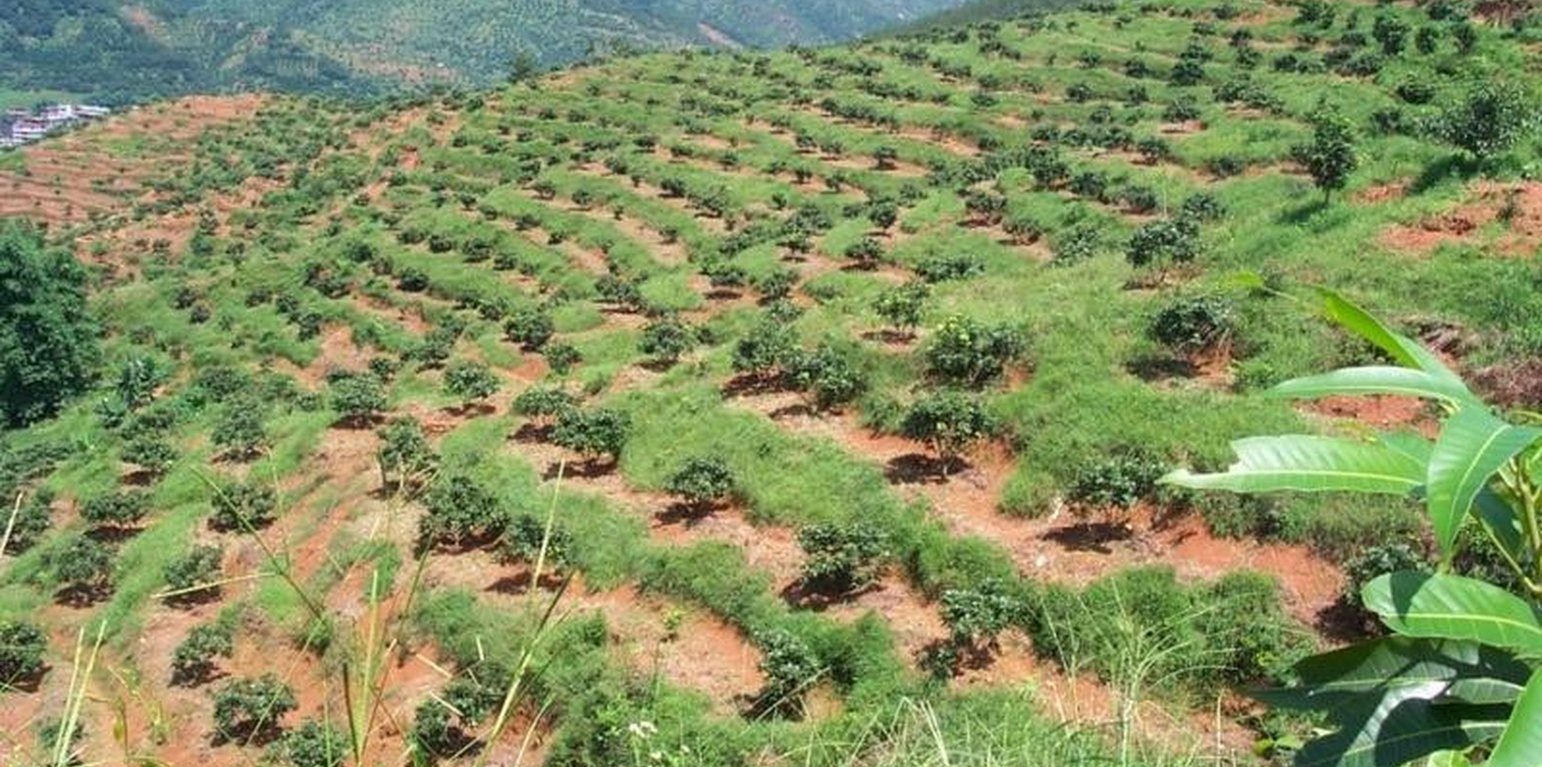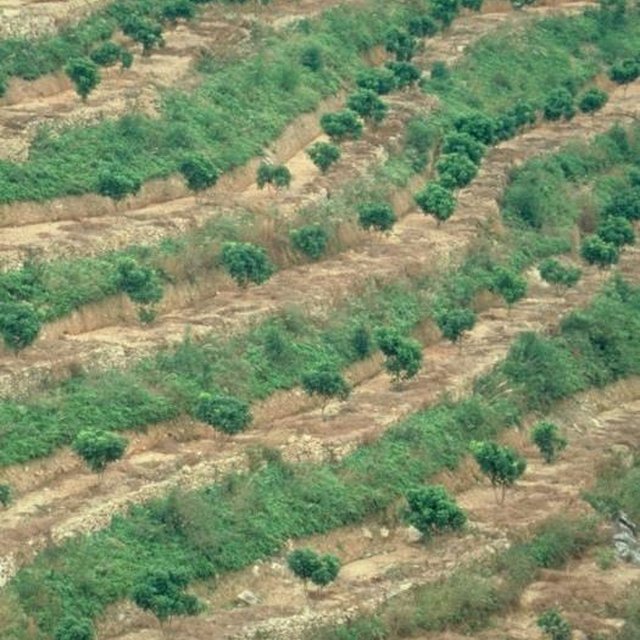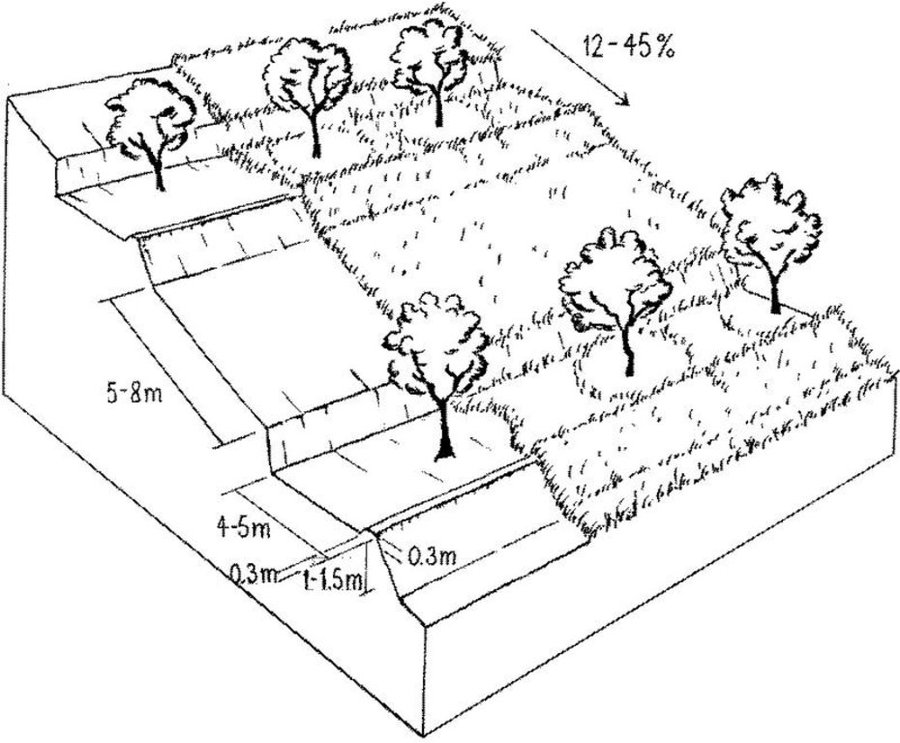



In this case study orchards were established between 1991 and 1992 on degraded and unproductive hillsides (wasteland), with slopes of 12-45%. This was achieved by constructing level beds on the contour, mainly as continuous slope-separated orchard terraces, but in some cases as individual planting platforms. Terrace construction was generally undertaken by hand using hoes and shovels.
Purpose of the Technology: A typical terrace has a 4-5 m wide bed and a 1.0-1.5 m high riser. Commonly, a raised earth lip (0.3 m high) is constructed on the terrace edge to retain rainwater. The terrace riser walls are not protected. Even before terrace construction there was little topsoil and in some places the upper subsoil had been lost to erosion. The establishment of fruit trees (lychee, Litchi chinensis and longan, Dimocarpus longan) therefore required deep planting holes (1 m3), filled with organic matter/manure, into which seedlings were planted. In subsequent years additional large quantities of organic matter/manure were applied in circular trenches to the side of the trees, succeeding trenches being gradually further away as the trees grew. Bahia grass (Paspalum notatum) was planted for SWC purposes as a cover crop, to stabilise terrace risers and to improve soil fertility. It has not been used for fodder in this case. The germination rate of bahia grass seeds is comparatively low; therefore instead of direct seeding, nurseries were established to produce seedlings. The bahia grass seedlings were transplanted onto the terrace risers and beds (leaving a space around each fruit tree) and on the hillside slopes between the terraces. The grass grew and spread quickly, restoring a protective vegetative cover following terrace construction.
Natural / human environment: The primary overall purpose of the technology was to rehabilitate degraded hillsides through the planting of economically valuable fruit trees. Terracing reduces soil erosion while retaining most of the rainwater. The application of organic matter creates improved rooting conditions, while restoring and maintaining soil fertility. The bahia grass further provides protective groundcover preventing splash erosion, increasing surface roughness, and thereby slowing down runoff velocity, while contributing to the restoration of the soil’s biological, chemical and physical properties. Irrigation ditches dug along the terraces help to reduce erosion further. This project was planned by SWC specialists: around 6,000 families were allocated orchard plots and provided with seedlings at a subsidised price.

Lieu: Yongchun County, Fujian Province, Chine
Nbr de sites de la Technologie analysés:
Diffusion de la Technologie: répartie uniformément sur une zone (55.0 km²)
Dans des zones protégées en permanence ?:
Date de mise en oeuvre: il y a moins de 10 ans (récemment)
Type d'introduction








| Spécifiez les intrants | Unité | Quantité | Coûts par unité (dollars américains) | Coût total par intrant (dollars américains) | % des coût supporté par les exploitants des terres |
| Main d'œuvre | |||||
| Voluntary and paid | ha | 1,0 | 840,0 | 840,0 | 100,0 |
| Matériel végétal | |||||
| Bahia transplants | ha | 1,0 | 435,0 | 435,0 | |
| Fruit tree seedlings | ha | 1,0 | 350,0 | 350,0 | 60,0 |
| Engrais et biocides | |||||
| fertilizer | ha | 1,0 | 145,0 | 145,0 | 100,0 |
| compost/manure | ha | 1,0 | 70,0 | 70,0 | 100,0 |
| Coût total de mise en place de la Technologie | 1'840.0 | ||||
| Coût total de mise en place de la Technologie en dollars américains (USD) | 1'840.0 | ||||
| Spécifiez les intrants | Unité | Quantité | Coûts par unité (dollars américains) | Coût total par intrant (dollars américains) | % des coût supporté par les exploitants des terres |
| Main d'œuvre | |||||
| Voluntary and paid | ha | 1,0 | 144,0 | 144,0 | 100,0 |
| Matériel végétal | |||||
| Bahia transplants | ha | 1,0 | 58,0 | 58,0 | 100,0 |
| Fruit tree seedlings | ha | 1,0 | 36,0 | 36,0 | 100,0 |
| Engrais et biocides | |||||
| fertilizer | ha | 1,0 | 84,0 | 84,0 | 100,0 |
| biocides | ha | 1,0 | 10,0 | 10,0 | 100,0 |
| compost/manure | ha | 1,0 | 44,0 | 44,0 | 100,0 |
| Coût total d'entretien de la Technologie | 376.0 | ||||
| Coût total d'entretien de la Technologie en dollars américains (USD) | 376.0 | ||||
organic matter/manure
rainwater retention
Quantité avant la GDT: 24.3
Quantité après la GDT: 3